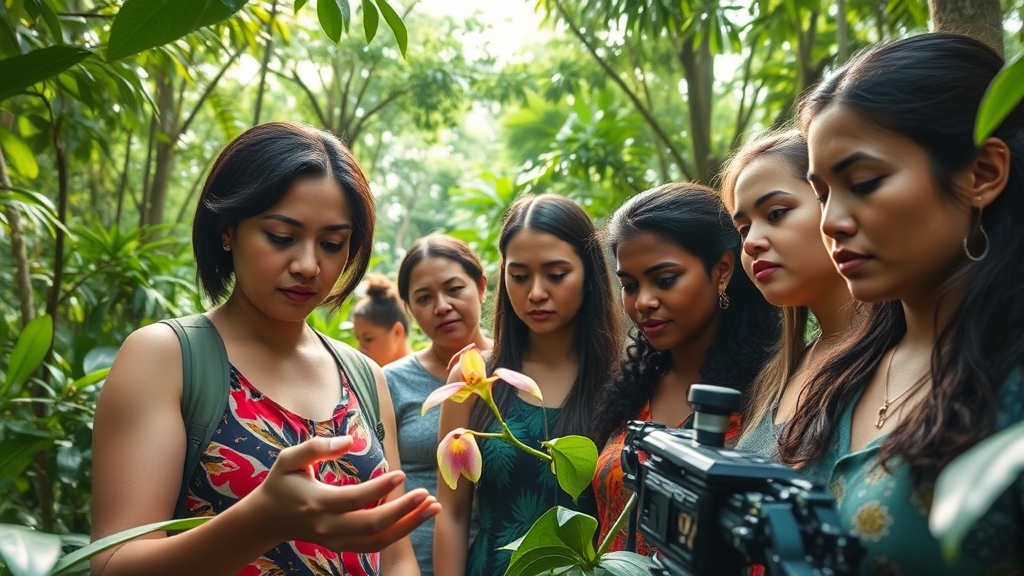Inspiring women in conservation are leading efforts to protect natural resources, promote sustainable practices, and empower communities. They introduce eco-friendly farming, renewable energy, and innovative technologies like AI for ecosystem monitoring. Many serve as bridges between science and local cultures, advocating for policies that support environmental justice. Their work often combines tradition with innovation, inspiring broader change. Keep exploring to discover the remarkable stories of these changemakers transforming our planet.
Key Takeaways
- Women leaders are pioneering sustainable practices, eco-friendly farming, and renewable energy to protect natural resources and uplift communities.
- They actively engage communities through education, grassroots initiatives, and fostering shared responsibility for environmental conservation.
- Innovators are integrating AI and modern technology like projectors to enhance ecosystem monitoring and environmental awareness.
- Many collaborate with indigenous and local groups, respecting traditional knowledge while promoting resilient, culturally appropriate conservation strategies.
- They advocate for cleaner energy alternatives, addressing pollution and deforestation, and demonstrating conservation as an everyday community effort.

Have you ever wondered how women are transforming conservation efforts around the world? It’s because they’re actively leading the charge, implementing sustainable practices that protect natural resources for future generations. These women understand that conservation isn’t just about protecting wildlife; it’s about fostering a balance that benefits entire communities. By integrating sustainable practices into local routines, they help ensure that environmental preservation goes hand in hand with economic stability. You can see this in action when women introduce eco-friendly farming methods, promote renewable energy use, or develop conservation-based businesses that uplift their communities. Their influence extends beyond individual efforts—they’re creating ripple effects that inspire broader change.
Women leading conservation through sustainable practices that benefit communities and protect natural resources for future generations
Community engagement plays a pivotal role in their work. Women often serve as the bridge between scientific knowledge and local traditions, making conservation efforts more inclusive and effective. Through community meetings, educational programs, and grassroots initiatives, they empower others to participate actively in protecting their environment. You might notice how they rally neighbors to conserve water during droughts or organize local clean-up campaigns that foster pride and ownership. Their approach fosters a sense of shared responsibility, ensuring that conservation isn’t seen as an external imposition but as a collective effort rooted in local values. This deep engagement helps build trust and encourages sustainable behaviors that last long after initial projects end. Additionally, understanding the importance of AI in conservation, these women are beginning to incorporate innovative AI tools to monitor ecosystems and predict environmental changes more accurately. Embracing technology enables them to enhance the precision and impact of their conservation initiatives. Furthermore, they are leveraging community-based strategies to ensure that conservation efforts are culturally appropriate and locally supported.
Many inspiring women in conservation also recognize that meaningful change requires listening to those most affected by environmental challenges. They work closely with indigenous groups, farmers, and youth, respecting traditional knowledge while introducing innovative solutions. Their leadership often involves advocating for policies that support sustainable development and environmental justice. By doing so, they help ensure that conservation strategies are culturally appropriate and economically feasible. Their efforts demonstrate that sustainable practices aren’t just about protecting nature — they’re about creating resilient communities that thrive in harmony with their surroundings. Moreover, they are increasingly aware of the environmental impacts of wood-burning and are actively promoting cleaner, more sustainable energy alternatives to reduce pollution and deforestation.
In essence, these women are reshaping conservation by blending sustainable practices with community engagement. They understand that lasting change depends on local participation and that empowering communities leads to more effective, culturally sensitive solutions. Their leadership proves that conservation isn’t a distant goal but an everyday commitment rooted in collaboration and shared purpose. As you learn about their work, you realize how crucial their contributions are in building a future where nature and people coexist sustainably. Additionally, they often utilize advanced projector technology to educate and raise awareness about environmental issues, demonstrating how innovative tools can support conservation efforts.
Frequently Asked Questions
How Do Women in Conservation Overcome Gender-Specific Challenges?
You overcome gender-specific challenges by challenging gender stereotypes that limit your opportunities and confidence. You seek out mentorship programs where experienced women guide you, offering support and advice. Building a network with other women in conservation helps you share experiences and strategies. By staying resilient and advocating for yourself, you break barriers, prove your worth, and inspire others to follow your lead in creating a more inclusive conservation field.
What Skills Are Essential for Women Pursuing Conservation Careers?
To succeed in conservation careers, you need strong leadership skills to motivate others and drive change. Technical expertise is equally essential, helping you understand ecological systems and conservation strategies. Combining these skills allows you to navigate challenges, collaborate effectively, and develop innovative solutions. Continuously build your knowledge and leadership abilities to make a meaningful impact in conservation efforts, and remember, your dedication can inspire others along the way.
How Can Men Support Women Conservationists Effectively?
You can support women conservationists by actively challenging gender bias in your environment and advocating for inclusive practices. Offer mentorship programs that empower women, providing guidance and opportunities for growth. Listen to their perspectives, validate their contributions, and promote equal leadership roles. Your efforts help create a more equitable space, encouraging women to thrive in conservation careers and ensuring diverse voices shape sustainable solutions.
What Are the Most Pressing Global Issues Women in Conservation Tackle?
You should know that women in conservation tackle critical issues like climate change, biodiversity loss, and environmental degradation, which threaten global stability. An interesting statistic shows women make up 43% of the workforce in nature-based sectors, yet face gender inequality barriers. They focus on community empowerment, advocating for sustainable practices and equitable access to resources, which is essential for long-term environmental protection and social progress worldwide.
How Has Women’S Leadership Transformed Conservation Efforts Worldwide?
You see that women’s leadership has profoundly transformed conservation efforts worldwide by promoting gender equity and expanding leadership roles. When women step into decision-making positions, they bring diverse perspectives that lead to innovative solutions and more inclusive policies. This shift empowers local communities, enhances sustainability, and drives meaningful change. As a result, conservation becomes more effective, equitable, and resilient, reflecting a global movement toward gender-balanced leadership in protecting our planet.
Conclusion
As you reflect on these remarkable women, remember they are the seeds of change, planting hope in the soil of our planet’s future. Their courage is the guiding light illuminating paths through darkness, and their passion is the steady flame that warms the coldest nights. Like the resilient tree standing tall amidst storms, these changemakers remind us that your voice and actions can also grow into a powerful force, shaping a brighter, greener tomorrow.








